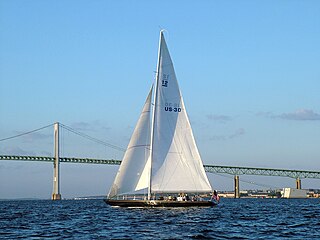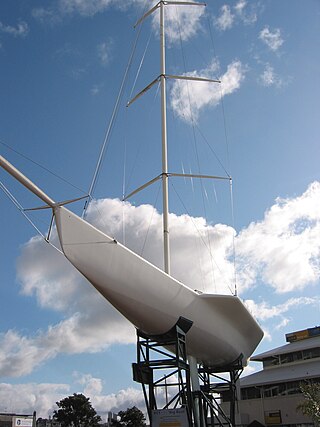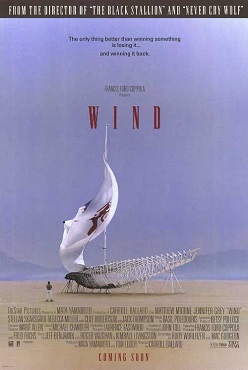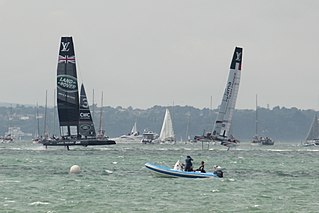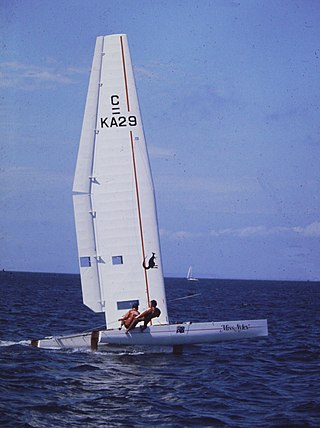| Year | Winner, Crew
and Nation | Opponent, Crew
and Nation | Match
score | Match
Location |
|---|
| 1961 | Hellcat II, John Fisk, Rod McAlpine-Downey UK | Wildcat, John Beery & John Hickok, USA | 4:1 | Long Island Sound, MA (USA) |
|---|
| 1962 | Hellcat, Ian Norris & Nocky Pope, UK | Beverly, Billy Saltonstall & Van Alan Clark, USA | 4:1 | Seacliff YC, USA |
|---|
| 1963 | Hellcat III S, Reg White & Rod Mac Alpine Downie, UK | Quest, John Munns (Skipper) & Graeme Anderson, Manager Max Press,Reserve Crew John Taylor and Peter Scarfe Representing The Australian Catamaran Assoc, Albert Smith-Observer and sponsored by the Sandringham YC, Victoria,Australia | 4:0 | Thorpe Bay YC Essex UK |
|---|
| 1964 | Emma Hamilton, A. R. Holloway & Reg White, Chapman Sands SC, UK | Sea Lion,Bob Smith & Jerry Hubbard, Eastern Multihull Association, USA | 4:1 | Thorpe Bay Yacht Club, UK |
|---|
| 1965 | Emma Hamilton, Reg White, [2] UK | Quest II, Australia, Lindsay Cunningham and John Buzaglo, Representing Blairgowrie Yacht Squadron, Victoria, Australia | 4:3 | Thorpe Bay Yacht Club, UK; |
|---|
| 1966 | Lady Helmsman, UK | Gamecock, Bob Shiels & Jim Bonney, USA | 4:2 | Thorpe Bay UK |
|---|
| 1967 | Lady Helmsman, UK | Quest III, Australia Peter Bolton, Skipper | 4:1 | Thorpe Bay UK |
|---|
| 1968 | Lady Helmsman, UK | Yankee Flyer, USA | | Thorpe Bay UK |
|---|
| 1969 | Opus III, Denmark | Ocelot, UK | 4:3 | |
|---|
| 1970 | Quest III, Australia | Sleipner, Denmark—Australian Crew- Bruce Proctor and Graham Candy | | |
|---|
| 1971 | | | | |
|---|
| 1972 | Quest III, Bruce Proctor, Graham Ainslie, Australia | Weathercock, Chuck Millican, Jack Evans, USA | 4:0 | Sorrento Sailing Club, Australia |
|---|
| 1974 | Miss Nylex, Australia Blairgowrie Yacht Squadron Crew Bruce Proctor and Graham Ainslie | Miss Stars New Zealand - West Coast Canterbury Syndicate From Canterbury Catamaran Squadron. Designer and Crew Bill Hende. Skipper Bret de Thier. Manager/Reserve Crew Wayne Nolan. - - NZ. | 4:0 | Sorrento Sailing Club,Victoria, Australia |
|---|
| 1976 | Aquarius V, Alex Kosloff and crew Robbie Harvey Cabrillo Beach YC, CA, USA | Miss Nylex, Sorrento Yacht Club in Australia, Bruce Proctor, Skipper and Graeme Ainslie | 4:3 | Sorrento Sailing Club,Victoria, Australia |
|---|
| 1977 | Patient Lady III, USA | Quest, Australia | 4:0 | Roton Point Club, Rowayton, CT USA |
|---|
| 1978 | Patient Lady IV, USA | Miss Lancia, Italy | 4:0 | Roton Point Club, Rowayton, CT USA |
|---|
| 1980 | Patient Lady V, USA | Signor G (for Signor Gividi), Italy | 4:0 | Roton Point Club, Rowayton, CT USA |
|---|
| 1982 | Patient Lady V, USA | Signor G | 4:0 | Roton Point Club, Rowayton, CT USA |
|---|
| 1985 | Victoria 150, Australia | Patient Lady VI, USA | | Roton Point Club, Rowayton, CT USA |
|---|
| 1987 | The Edge, Australia | The Hinge, UK | | McCrae Yacht Club, Victoria, Australia |
|---|
| 1989 | The Edge II, Simon McKeon & David Churcher, Australia | Wingmill, USA | | McCrae Yacht Club, Victoria, Australia |
|---|
| 1991 | The Edge III, Simon McKeon & David Churcher, Australia | Freedom's Wing, Pete Melvin and Steve Rosenberg, USA | 4:1 | McCrae Yacht Club, Victoria, Australia |
|---|
| 1996 | Cogito, Duncan MacLane
USA | Yellow Pages The Edge III,
Australia | 4:0 | McCrae Yacht Club, Victoria, Australia |
|---|
| 1997 onwards | No races held in this format under this name. Please see ICCC from this point forward |
|---|




